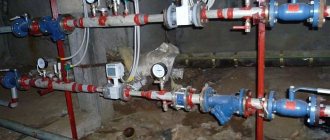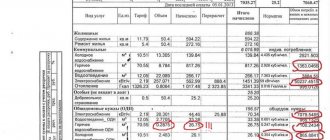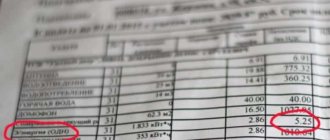Payment receipts for utility services have recently included a column designated “DHW heating.” This is a separate type of service for which residents have to pay monthly.
Failure to make payments for it leads to the formation of debt. Not all payers have an idea about and what it means in the payment document. At the same time, the legality of paying this type of utility bills is established by law.
What is DHW in the receipt?
The abbreviation “DHW” is nothing more than hot water supply. They are provided with apartments in houses. In this case, the hot water supplied to homes must correspond to a certain temperature regime. DHW does not mean only hot water. This is thermal energy used to heat water to the required temperature.
DHW can be supplied to apartments through central and autonomous systems. The first option is the most common and is used in apartment buildings. Water is heated at a thermal station, after which the resource is supplied to homes. The autonomous system has found application in private homes. A boiler or a special boiler installed in the premises heats the water. The resource is subsequently distributed only within one private home.
Hot water supply is paid only by citizens using the central heating system. Users of an autonomous system do not pay for the resource itself, but only for heating it using electricity or gas.
Note! Receipts also contain the column “DHW at one-way service station”. The last abbreviation means general house needs (pressure testing of pipes, preparation for seasonal heating, delivery of coolant to common areas). Domestic hot water supply on one heating system implies the consumption of energy to heat water, which will be used for the needs of all inhabitants of the house, and not just individual apartments in it.
Where can I find the line?
The invoice-receipt for payment of housing and communal services (HCS) is drawn up in the form of a table. The left column lists the types of services, and their characteristics are given horizontally to the right. The second line in the table from the top is called “Hot water supply.
| Accrued | Unit change | Tariff\Size boards | Col. | Accrued | Benefit | To pay |
| Cold water supply | ||||||
| Hot water supply | M3 | 198,19 | 1,80 | 356,74 | 89,18 | 267,56 |
| Water disposal |
Often in an apartment building, residents see separately in their document how much they need to pay for the consumption (measured in cubic meters) of hot water (with characteristics that comply with the regulations) and the cost of heating their apartment. The payment for thermal energy is stated in these two lines of the receipt.
Hot water law
Until the beginning of 2014, a one-component scheme was in force in Russia, according to which receipts for payment of thermal energy were generated. The basis was taken only by the cubic meters that residents consumed per month. Their number was multiplied by the tariff and the fixed figure of 0.06 Gcal. The last value was derived from calculations. It means the approximate amount of energy required to heat 1 m3 of water.
Government Resolution No. 406, adopted on May 13, 2013, fixed a new tariff in the water supply system. It became two-component. This tariff now takes into account both cold water and thermal energy.
In all receipts, the columns “DHW” and “DHW heating” began to be written separately. The basis of the 2-component tariff is not only cold water intended for domestic hot water, but also heat energy.
Is it necessary to install water meters? No! Law 261 on the installation of meters.
The line “DHW” implies an accrual for the volume of water consumed during the month that passed through the hot water supply flow meter. If the water meter does not work or is not present in the home, then the volume of water calculated according to the average indicator or a unified standard taking into account the number of officially registered persons is taken as a basis. The volume of DHW supply is calculated according to the same scheme as the tariff for cold water supply.
The line “DHW heating” indicates the amount of energy spent on heating the resource supplied to the apartment to the required temperature. Indications about the amount of energy used during the month for heating water are taken from the general house flow meter.
The approval of a two-component tariff is due to the fact that previously organizations charging utility bills did not take into account the energy consumed by heated towel rails and risers. Due to their use, the rooms in the houses were also slightly heated. But apartment residents used such thermal energy for free.
The legality of the two-component tariff and the inclusion of a column about hot water heating in receipts is questioned by many payers. Some of them stop paying this tariff. Such an action on the part of residents is unjustified, since the obligation to pay this tariff is fixed both in the housing complex and in government decree number 406.
Also, another act fixes the obligation of residents to pay for this service. Government Decree No. 354 of May 6, 2011 contains an order obliging consumers to pay for utility services on time. This obligation also applies to the service for the supply and heating of domestic hot water. This Resolution also prescribes paying for the service in full and not allowing late payments.
What it is?
In the payment document, among others, there is a line - DHW.
This position assumes the cost of energy expended to provide residents with hot water according to established standards. This indicator combines the cost of hot water consumed in the system and the cost of heating it in accordance with approved standards.
Hot water in houses that have a centralized hot water supply is paid according to its consumption meter. But at the same time, the tariff for the supply of a cubic meter of water depends on the region where the supply and consumption of water occurs.
The tariff takes into account operating and administrative costs, the cost of water purification, as well as the energy spent on heating it to the regulatory level.
Economic indicators are established by the authorities of a given region and relate specifically to the consumption of hot water , which must necessarily comply with the characteristics of the standards.
If the water is actually colder than normal, then the user has the right to complain to the Criminal Code. Flow accounting can be carried out both using metering devices serving the entire house, and individually.
Water heating equipment
A water heater is installed in an apartment building. Failure of the device does not affect the tariff change. But the repair of a broken water heater is paid for by the residents of the house. The device is part of the common property. If it breaks down in the housing and communal services receipt, in the line “Repair of property” there will be a certain amount spent on fixing the problem.
Important! Residents of apartments equipped with an autonomous system do not have to pay for water heating. They do not use the central system and pay only for the amount of electricity or gas spent on heating the resource with a home boiler or boiler.
What is hot water for hot water supply?
. It is important for those who do not have individual metering devices installed. They pay for utilities and services according to the standard established by the regional government. The standard depends on the number of people registered in the apartment, and not on actual consumption.
The reason for this innovation was the additional use of energy. Risers and heated towel rails connected to the hot water supply system consume thermal energy, but this consumption was not previously taken into account in calculations of utility bills. Since heating fees can only be charged during the heating season, heating the air through the use of a heated towel rail was not paid for as a utility service. The government found a way out of this situation by dividing the tariff into two components. Water heating is one of the most expensive utilities.
Component thermal energy
This expression refers to heating cold water. The meter is not fixed on the component, which makes it impossible to calculate this indicator using the meter. When calculating the component, the following data is taken into account:
- tariff set for hot water supply;
- calculation of heat loss;
- funds spent on maintaining the centralized system;
- expenses incurred for transferring a resource.
The service is calculated based on the available readings from the common house hot water flow meter. The amount of energy available in the hot water is also taken into account. This indicator is calculated individually for a separate apartment.
You can calculate the amount of energy by multiplying the current water meter readings and the specific energy consumption.
This product is multiplied by the number established by the tariff. The resulting value is the same contribution recorded in the receipt.
How to calculate it yourself: step-by-step instructions
To independently calculate the amount of the next payment for hot water supply, you need to use the formula:
Pi = ViP x Tcr, where:
- ViP is the water consumption for the payment period;
- Tkr is the value of the tariff for hot water supply;
- Pi — — payment for the control period.
Calculation example
The following indicators were used for the calculation:
- The amount of hot water used, measured by the water meter for February 2021, was 5 cubic meters (m3) (ViP - in the formula).
- The tariff for the region is 150 rubles. per 1 cubic meter (m3) (Tcr - in the formula).
The rent for the apartment is calculated as follows: 5 m3 x 150 rubles. = 750.00 rubles. The fee for hot water supply to an apartment is RUB 750.00.
How to make your own calculation
The correctness of the amounts calculated by settlement centers can be verified. To calculate the cost of hot water supply, you will first need to find out what the price of thermal energy is at a given time. The final amount of the calculation is influenced by the presence of a water meter in the home. If there is a flow meter in the apartment, then the readings from it are taken into account. If there is no water meter in the home, then the standard is taken into account in the calculations. This is an average indicator of the consumption of thermal energy used to heat water. The standard is approved by the energy supply company.
If there is a general energy flow meter in the house and a water meter in a separate apartment, the amount for hot water supply is formed on the basis of the indicators of the general house flow meter and the subsequent proportionate distribution of the resource among apartments. If the house does not have a general house flow meter, then the calculation is made based on data from individual water meters and the established norm of energy consumption per 1 m3.
The amount that a resident needs to pay for hot water supply can be calculated using a single formula:
- P = Vhot.in * Tcold.in + (Vheat.energy * Vhot.in / ∑Vhor.in * Theat.energy)
In this formula, the designations are deciphered as follows:
- Vhot.v is the volume of hot water consumed in the home over a monthly period;
- Tcol.w – cost of cold water at a fixed tariff;
- Vtherm.energy – the amount of heat energy used during the month to heat cold water;
- ∑Vgor.v – the total amount of hot water consumed by all apartments in the building during the month;
- Theat energy – the tariff set for heat energy.
Using this formula, DHW is calculated for those apartments where individual flow meters are installed. If the housing does not have these, then the calculation is made on the basis of the standard established in the region. Its value must be divided by the number of registered occupants of the apartment. However, the final result is inaccurate. Housing organizations involved in settlements additionally include in receipts expenses for repairs and maintenance of metering devices in houses.
When making calculations, it is important to find out how hot water supplies the apartments. It can be supplied either through common house equipment or through a centralized system. If DHW is supplied to the apartment using common building equipment, and it has hot and cold water supply meters, then the calculation is done in the following way:
- DHW flow meter readings * tariff for cold water supply * cost of heat energy.
If an apartment dweller’s hot water meter shows 2 m3, the tariff for cold water is 14 rubles, and the cost of heat energy is 2000 rubles, then the calculation will be as follows: 0.06 gigacalories * 2000 = 240 rubles. + (14 * 3) = 282 rub. This is the price of 2 m3 of hot water. The number 0.06 indicates the approximate amount of energy used to heat 1 m3 of water. If your home does not have water meters, then you must first multiply the standard by 0.06, and then multiply the resulting product again by the heat tariff.
What is cold water for domestic hot water and how is payment for this service calculated?
Water heating is an important service provided by the service organization. Payment is made in accordance with the law on hot water supply. The calculation is carried out automatically, but each consumer can check the received calculations. In case of an error, the difference must be compensated by recalculation. An additional column will appear on the receipt.
- The function is to distribute water to water intake points.
- The standard diameter of the pipes used is 15 mm.
- Pipes made from steel or PVC can be used.
- When carrying out repairs, it is not recommended to use options with a smaller diameter, as this can lead to an increase in pressure in certain areas of the system.
- To organize the correct water supply, tees and manifolds are used. A manifold supply is required when it is necessary to carry out hidden installation when servicing a large number of apartments with the system.
The question arises whether it is legal to charge one tax for sewerage. Most of the water supplied through pipes to apartments, after being used for laundry, dishwashing or hygiene purposes, is drained into the sewer system, which requires appropriate maintenance, just like the water supply system. The costs of this work must be borne by the residents themselves.
Hot water supply ODN in the receipt is a fee for the use of hot water for cleaning the entrances, as well as for heating them in the winter. The total amount of expenses for the month is distributed among all apartments of a residential building in proportion to their area. The number of registered residents in one apartment is not taken into account.
The source of heat for heating water in the main is boiler houses or thermal stations. In this way, a large volume of water can be driven through. The central highway is used to supply multi-storey buildings, and even microdistricts. According to the method of obtaining heat in a centralized way, systems are divided into:
Such accounting must be carried out using special meters. At the same time, the legislation allows the installation of meters to control the coolant at the site. In particular, meters are installed to remotely determine indicators that do not affect commercial heat metering and the accuracy and quality of measurements.
You may like => Statistics of Changes in Decisions by Appeal of the Moscow State Court
Even if the money for hot water supply has been paid, then if violations and incorrect calculations are detected when charging fees by the relevant organizations, the paid funds must be returned to the residents. Otherwise, the persons responsible for returning the money, on the basis of Art. 395 of the Civil Code of the Russian Federation, will be forced to return the amount of the debt with interest or pay a penalty for failure to fulfill obligations (if the condition for payment of the penalty is contained in the agreement between the parties (suppliers, organizations and consumers).
- from the cost of one unit of thermal energy (gigacalories or Gcal), established on a legislative basis;
- financial costs of organizations regulated by the state for the maintenance of central hot water supply from the points of thermal power plants to the point of operational inputs of the zone of responsibility of consumers and organizations;
- the cost of heat loss of one unit of thermal energy (1 Gcal) in pipelines from central heating points to the entrance to the end-user areas;
- cost of water transportation.
Complaint due to incorrect calculation of receipt
Utility billing centers distribute the amounts spent on the repair of a common house water heater among all residents of the house. However, they do not always take into account the fact that some homes are equipped with an autonomous system. As a result, the owners of such apartments are forced to pay for equipment that they do not use.
There may also be cases when residents receive receipts with increased rates. In such situations, it is recommended to contact the management organization. You can visit its settlement department or write a letter demanding an explanation of why such amounts were accrued.
If the Criminal Code does not intend to clarify the situation, then it is necessary to write a complaint. The document is transferred to the management of the management company or its secretariat. You can also submit your complaint to the Legal Department. The management of the management company is given a month to respond. If the management organization confirms the fact of incorrect calculation, then it must make a recalculation. Based on this, the consumer will be compensated for the overpayment for hot water supply.
Important! In situations where management organizations do not respond to complaints and do not take active actions, it is recommended to complain to the court. The claim is sent to the specified authority. It is important to state the essence of the violation and your requirements. In this case, it is necessary to refer to legislative acts.
The legality of charging payments for heating hot water can also be challenged in the prosecutor's office. An alternative option is to contact the authorities that control the work of the management company. Citizens can contact the Ministry of Construction, the Federal Antimonopoly Service, housing inspectorates, and Rospotrebnadzor.
Calculation of the cost of hot water supply
Electricity used to heat water is not free. Settlement centers legally charge payments for. It is important to take into account that only from the beginning of 2014 a new line appeared in receipts regarding the need to pay for hot water heating. The legality of such charges is established by Government Resolution dated May 13, 2013, number 406.
How to determine the cost yourself
The cost of heating cold water is indicated in the receipt. It is quite simple to calculate the total amount for cold and hot liquids, but few people know how to calculate the amount of payment for additional services.
How is water heating calculated in the bill in summer and winter, and what data will you need to know:
- You definitely need to know what tariff is set in the region.
- What losses did the management company incur for transporting the resource?
- How much energy was actually used to achieve the required temperature.
- How much resource is spent each month?
Not all management organizations provide such data to residents of apartment buildings. However, any person can request this information from the HOA or management company, and employees of the legal entity are obliged to provide reliable information on payment for apartment supply services.
If you refuse to respond to the request, the applicant can file a complaint against the employees of the management company with Rospotrebnadzor. Having received all the necessary data, you can independently calculate and compare the heating bill indicated in the invoice.








